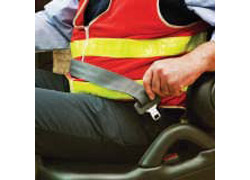 Stuart Taylor |
Stuart Taylor is Managing Director of Mentor FLT Training Limited, the UK's leading provider of training and associated services for all types of materials handling equipment and workplace transport.
It is a worryingly common myth among forklift users that if a seatbelt is not specified during a risk assessment, then it doesn't have to be used. This is absolutely not the case.
In the UK, the HSE's rule is: "Where restraining systems are fitted, they should be used."
Some forklift operators may prefer to not wear a seatbelt, but as a manager or supervisor, it is your responsibility and obligation to ensure that their safety outweighs any notion of giving them an easy life. The main goal of your safety policy should always be to reduce the risk of accidents and harm.
Any rare exception to the seatbelt rule will need to have extremely good justification behind it, based on a thorough, realistic risk assessment, and it would usually require not just one but a combination of checks to be in place that dramatically reduce the risk of a lift truck tip over.
Minimise the consequences Seatbelts are required where there is roll-over danger |
As is the case in all vehicles, ignoring your seatbelt won't cause an accident, but it could mean that the consequences are more severe. In cars, the seatbelt is there to prevent the driver from hitting the wheel or the windscreen in the event of a collision, but since forklifts travel at slower speeds than cars, many operators question the need to use them.
However, forklift cabs are open. If the operator is not wearing a seatbelt, then there is a risk that they could fall out of the cab or even be thrown from it if the truck became unstable and turned over.
Often, the operator's natural instinct when a forklift starts to tip is to try and get out. But this just increases the risk of crush injuries were the operator to get caught between the cab's framework and the floor - a process known as mouse-trapping.
The role of a seatbelt in a forklift truck is to prevent this from happening. It stops operators from trying to jump free or from sliding off their seat and outside the truck's cab, which is also known as its roll over protection system (ROP).
The cost of avoidanceIn 2016, a major UK steel firm was heavily fined following the death of a forklift operator who was found to not be wearing a seatbelt.
The operator was fatally crushed after reversing his forklift at speed and clipping a step, whereupon he was thrown from the vehicle and crushed under its weight when it overturned.
Although the seatbelt was not the root cause of the accident, its absence resulted in tragic consequences, which suggests complacency towards safety and a lack of guidance from management.
The hearing was told that the firm had maintained an endemic culture of "not being bothered to wear a seatbelt" for numerous years.
Although the operator had received training instructing him to wear a seatbelt, the rule had never been enforced by the company.
Since the incident, the firm has told staff that failure to wear a seatbelt would result in a dismissal.
Make it officialFatalities or serious injuries stemming from situations like the above are still far too common in the workplace, and it is up to companies to drive a change in staff attitudes towards wearing seatbelts on forklifts.
Operators carrying out similar tasks in the same environment day to day can soon become complacent over safety, and this is when managers need the confidence to step in and challenge bad practice. After all, wearing a seatbelt won't prevent an accident from happening - it's down to the operators to ensure work is carried out safely. But they need to be reminded by managers that wearing a seatbelt could dramatically minimise the consequences for them should the worst happen. And these should not just be one-off reminders; your safety measures need to be continually reinforced to be most effective. Refresher training and monitoring are great places to start.
If you haven't already done so, include seatbelts in your company policy today. This will make them a legal requirement that cannot be misinterpreted or ignored, and could ultimately save your colleagues from serious injury, or worse.